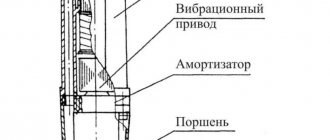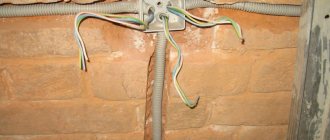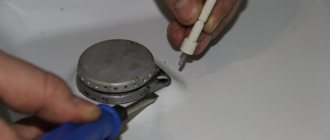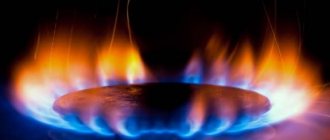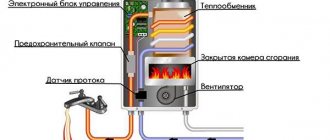The main and main purpose of geysers is to quickly heat cold water in an apartment or private house. But this device, despite its relatively simple design, requires regular maintenance, otherwise it works worse and worse until it completely stops performing its functions. In a situation where the gas water heater does not heat the water, there are two options: the first is to seek advice and help from specialists, the second is to try to diagnose and fix the problem on your own. In the latter case, you need to know the operating principle of a gas water heater and understand the types of breakdowns that could occur with the device.
Principle of operation
The method of operation of an instantaneous gas water heater is as follows:
- The gas burns and heat is released.
- The heat exchanger heats up and transfers thermal energy to the water.
- The heated water flow is directed into the pipeline.
- Combustion products exit through the chimney.
A typical column consists of the following elements:
- Frame. Made from heat-resistant metal alloys, it hides parts. Some water heater models include an electronic display that helps you monitor the operation of the equipment. If the device breaks down, a warning signal appears on the screen.
- Thermostat. Maintains constant water temperature.
- Heat exchanger. This is the main heating element.
- Gas valve. When the valve is turned on, it provides fuel supply.
- The combustion chamber. In it, gas is converted into heat.
- Ignition system. It can be mechanical or automatic.
- Battery.
- Gas-burner.
- Smoke exhaust.
- Fan. Accelerates the removal of waste waste.
- Water valves (inlet, outlet).
If a geyser does not heat water well, the root cause often lies in damage to one of the above elements. To normalize the operation of the water heater, it is necessary to repair the damaged part or replace it with a new one.
Descaling the system
The water in Russian pipes has never been of good quality, therefore, during the operation of gas equipment, various salts and metals accumulate on the internal sections of the heat exchanger. In this case, the diameter of the outlets gradually narrows, and the scale layer reduces the thermal output of the entire system.
It turns out that with an acceptable water pressure, the pipes do not heat up sufficiently, and we get a significant decrease in efficiency. But this problem can be dealt with on your own. To clean the radiator from scale, simply rinse it. Depending on the degree of contamination, citric acid is used, and in difficult cases, specialized detergents are used.
Dismantling the geyser heat exchanger
To fully clean the system, it is necessary to remove the radiator from the gas water heater. Washing some individual parts is less effective, but if it is impossible to dismantle the element in principle, then you have to be content with little.
Before dismantling, it is necessary to turn off the column and turn off the gas and water supply taps. You also need to drain all liquid from the system. We release the panel behind which the radiator is located by unscrewing the fasteners and remove it. Carefully remove the heat exchanger, trying not to tilt it, because there is probably water left there.
Cleaning the heat exchanger from scale
The cleaning procedure itself is extremely simple: pour citric acid or a specialized product into the radiator and leave it for a couple of hours in some warm place. During this time, the composition will react with the scale and discharge it. Next, we rinse the heat exchanger with running water and install it in place in the reverse order of disassembly. If necessary, repeat the cleaning procedure.
Major breakdowns
There are many reasons why a gas water heater does not heat water. To understand how to repair a heating unit yourself, if necessary, you need to familiarize yourself with each of the breakdowns and learn effective methods for eliminating it.
Chimney blockage
A smoke exhaust duct heavily clogged with debris cannot provide sufficient draft. If the pipe is poorly permeable, the water heater’s protective system is immediately activated, and the operation of the device is instantly blocked.
You can check the presence of traction in the following way:
- Light a match.
- Bring it to the vent.
- Assess the state of the fire.
If the flame deviates, there is draft; if it burns evenly, there is no draft. This problem is solved by cleaning the chimney, ensuring the unhindered passage of air through the pipe.
A chimney clogged with smoke and soot cannot provide the draft necessary for work, so the water heater’s protective systems stop the gas supply Source terman-s.ru
Ignition system failure
Sometimes when using a water heater, problems with ignition occur. This only applies to automatic devices that operate on batteries. Typically, batteries run out a little earlier than expected according to the instructions.
To understand why the geyser does not heat water after replacing the battery, you should carefully inspect the contacts. If the latter have oxidized, they need to be cleaned, then try to ignite the unit again.
First aid
Before looking for a breakdown and calling a repairman, check that all conditions for normal operation of the column are met.
What to look for:
- If the water is not hot enough, check the temperature regulator and, if necessary, turn it to the desired value;
- If the device is working at maximum, the pressure is very good, but you need to make the water hotter, open the tap halfway;
- Check whether the gas tap is fully open, especially if you recently turned off the gas due to repairs or departure;
- If the dispenser operates on liquid gas, call a technician to inspect the cylinder and check its serviceability;
- Check to see if the cold water is turned on anywhere;
- Compare the temperature of the hose at the dispenser and the mixer. If it is different, the tap needs to be cleaned;
- Check if the filters are clogged.
If all of the above is working properly, but the water heating system still does not work well, you need to look for a breakdown in the device itself.
Video description
The column does not heat evenly. What to do.
Insufficient water pressure
There are cases when a geyser does not heat water due to false alarms of safety sensors. When the water pressure is excessively weak, the system immediately turns off the device.
How to solve a problem:
- Contact the utility service. There may be a water leak in the pipeline.
- Clean the filters.
- Remove scale from the water heating element.
- Check the membrane.
Sometimes, with minimal water pressure, the gas water heater heats it up too much. This only applies to older models, since they do not have a protection system: in the absence of water, they continue to burn. For safety reasons, it is advisable to replace the outdated device with a modern one.
If cold water flows with the same weak pressure as hot water, the problem of the geyser is a faulty water supply Source cosmo-frost.ru
Burner faults
It happens that the water heater functions, but does not heat the water to the required temperature. This often occurs as a result of poor combustion. Then the liquid simply does not have time to warm up to the required levels. In such situations, the fire in the burner usually smokes and has a specific hue. These signs indicate that the igniter or burner is clogged with soot or soot.
Disassembling the burner device and thoroughly cleaning clogged parts will help get rid of this problem. If there is a gas filter, it should also be checked for clogging.
In columns with piezo ignition, the igniter must burn constantly, because when the hot water tap opens, it must ignite the main burner Source cosmo-frost.ru
Sudden loss of device
If the water does not heat up because the gas water heater goes out immediately or some time after being turned on, the following breakdowns are possible:
- The contact between the magnetic valve and the thermocouple is broken. This occurs due to short circuits that occur when the insulation is damaged. As a result, the device randomly lights up and goes out. This problem is eliminated by replacing the wires.
- Damage to the automatic control system of the water heater. You can detect such a problem after a short observation of the operation of the device. If it functions normally for ten minutes, but then goes out and lights up again, the combustion sensor must be repaired.
Advice! It is better to entrust the repair of electronics of gas equipment to specialists.
Repairing the electronics of a geyser requires certain knowledge and skills, so it is better to entrust it to professionals Source remont57.kh.ua
Water supply blockage
The reason for poor heating of water in a gas water heater may be a clogged water supply. To fix it you need:
- Set the mixer to the third position.
- Fully open the taps and damper.
- Place a container for liquid.
If the above steps do not help, you should contact the utility workers. Old pipes may need to be replaced.
What else can interfere with water heating?
If diagnostics have shown that there are no malfunctions in the operation of the gas heater, but the water heater still does not heat or heats the water poorly, you should listen to the recommendations of professionals.
Among them are the following:
- If the water has always been hot, and then its temperature became insufficient, it is worth checking the gas pressure coming from the pipeline or cylinder. It is not recommended to do this yourself; it is better to call representatives of the gas service.
- The water may remain cool if mixing cold water with hot water is not working correctly You can easily check this by touching the pipe through which water flows from the pump to the tap. If the pipeline is hot and the water coming out of the tap is slightly warm, it is worth repairing the mixer or adjusting its operation.
- When the temperature of the water supplied from the tap changes sharply, the gas heater periodically turns off, it is worth checking the filters in the water heating system and in the mixer.
To increase the temperature of the water leaving the boiler, it is worth opening the gas supply tap as much as possible, and opening the valve responsible for the flow of cold water only halfway. At maximum burner power, the flow of cold water will decrease. This will provide better heating.
conclusions
If it happens that the gas water heater malfunctions and begins to heat the incoming water poorly, you should pay attention to its internal walls - perhaps contaminants in the form of dirt and scale have accumulated there. Such deposits can be easily removed yourself and your equipment will definitely return to its original condition.
Sources
- https://seositi.ru/otoplenie/kotly/gazovaya-kolonka-ploxo-greet-vodu.html
- https://tehnika.expert/klimaticheskaya/gazovaya-kolonka/pochemu-ne-greet-vodu.html
- https://sovet-ingenera.com/otoplenie/vodonagrevatel/pochemu-gazovaya-kolonka-ne-greet-vodu.html
- https://tehnofaq.ru/pochemu-voda-v-gazovoj-kolonke-ne-nagrevaetsya/
- https://oteple.com/prichiny-pochemu-gazovaya-kolonka-ne-greet-vodu/
- https://cosmo-frost.ru/gazovye-kolonki-i-kotly/neispravnosti-gazovye-kolonki-i-kotly/pochemu-gazovaya-kolonka-ploxo-greet-sovsem-ne-greet-vodu/
- https://www.o-vannoy.ru/gazovye-kolonki/ne-greet-vodu/
- https://eurosantehnik.ru/ploxo-greet-gazovaya-kolonka.html
Types of filters
They will protect the boiler from the ingress of finely dispersed impurities, scale, and, as a result, the occurrence of noise effects.
The following types of filters are installed on water heaters and the inlet group of the water supply system:
- Rough cleaning. Captures mechanically suspended particles (up to 1 µm).
- Fine cleaning. Ion filters additionally remove small particles of impurities, including metals. Membrane (osmosis method) additionally neutralize chemical impurities.
- Cleaning systems using various adsorbents (physico-chemical method).
The most effective are combined types of filters with multi-stage cleaning.
Filters for water
For what reasons does fuel burn incompletely?
During the physicochemical process of combustion of saturated hydrocarbons and its subsequent products, carbon dioxide is formed. It happens that there is no fresh air supplied and during the combustion process, in addition to carbon dioxide products, carbon monoxide is formed in the form of pollution and soot. By the way, carbon monoxide exists in all gas burners; this is its usual state. This cannot be avoided. Sometimes, to keep the internal walls of the burners clean, combustion chambers are installed, where the combustion process takes place. In water heaters operating on ducts, such chambers are not used. In order to look at the gas combustion process, you can remove the front panel of the gas burner and look at the inside of the device.
Sometimes the panels are dirty and smeared with soot. To clean them, ensure the flow of air into the chamber and clean the device. For one cubic meter of gas to burn properly, it will require about ten parts of fresh air. In devices designed to generate gas, everything is provided in advance; with the help of a specially installed air valve, free access of fresh air into the chamber can be ensured.
Remember that you should not neglect cleaning the heat exchanger panels, because this could result in poor water heating and excessive fuel consumption.
Fixing a leak in a gas water heater
This problem is relevant both for new equipment and for old gas boilers that have been operating for several years. The column can leak for a number of different reasons, but the main ones are the following:
- incorrect connection of water hoses;
- absence or wear of gaskets at joints;
- A fistula has formed in the radiator tube.
There are no problems with the first two cases: we go through and reconnect the hoses, not forgetting to lay the seals.
Experts recommend using silicone gaskets, especially for gas equipment. They provide decent tightness and last much longer than ordinary rubber or tow.
As for the fistula, you can try to solder it, but this is only a temporary solution. If the material begins to deteriorate and crack in one place, it means that soon the entire radiator will be covered in such fistulas. Therefore, the only correct option is to completely replace the heat exchanger.
Sealed geyser
